Oct 19, 2005
On-the-Move Interaction with Everyday Objects
MIT researchers have designed and developed a bracelet called ReachMedia that is able to identify objects the user is holding and then to connect to the Internet, to search information concerning these objects. The system is also able to detect and recognize hand gestures through an integrated accellerometer, allowing the user to interact with available information.

More to explore
ReachMedia: On-the-Move Interaction with Everyday Objects, International Symposium on Wearable Computers (ISWC'05), Osaka Japan, October 18 - 21, 2005
14:45 Posted in Wearable & mobile | Permalink | Comments (0) | Tags: Positive Technology, wearable
Oct 14, 2005
Feel like an expert surgeon
19:40 Posted in Cyberart | Permalink | Comments (0) | Tags: Positive Technology
3rd European Conference on Positive Psychology
From Monday July 3rd to Thursday July 6th, 2006, University of Minho (Portugal) will host the 3rd European Conference on Positive Psychology. In this new century, Positive Psychology has become one of the major approaches to the study of individual behaviour and social processes. In this innovative and promising scientific field, a growing number of theoretical, empirical and applied projects are investigating positive psychological issues such as the subjective well-being, creativity, leisure, personal strengths and resources, and their implications on individual, social and community development. This Third European Conference on Positive Psychology provides an opportunity to discuss and develop new theoretical and empirical perspectives, to foster networking among scholars, and to explore new applications of Positive Psychology.
For more information visit the conference's web site
19:18 Posted in Positive Technology events | Permalink | Comments (0) | Tags: Positive Technology
Oct 13, 2005
Free Survey - Human Movement Tracking and Stroke Rehab
This free-downloadable report by Huiyu Zhou and Huosheng Hu from Essex University (UK) reviews recent progress in human movement tracking systems in general, and stroke rehabilitation in particular.
It is a wonderful resource for all researchers interested in technology-enhanced rehabilitation after stroke
17:20 Posted in Cybertherapy | Permalink | Comments (0) | Tags: Positive Technology, virtual reality, cybertherapy
Pervasive Health Conference
Pervasive Healthcare Conference 2006 will be held in Innsbruck, Austria (dates to be defined). Pervasive Healthcare is emerging both as a solution to many existing healthcare problems such as significant number of medical errors, considerable stress on healthcare providers, and partial coverage of healthcare services in rural and underserved areas worldwide, and as an opportunity to provide better healthcare services to an increasing number of people using limited financial and human resources.  Pervasive healthcare can be defined as healthcare to anyone, anytime, and anywhere by removing locational, time and other restraints while increasing both the coverage and quality of healthcare.
Pervasive healthcare can be defined as healthcare to anyone, anytime, and anywhere by removing locational, time and other restraints while increasing both the coverage and quality of healthcare.
Conference topics include, but are not limited to: technologies situated "on the patient", technologies situated "in the environment", medical aspects of pervasive healthcare, and management of pervasive healthcare.
For more information visit the conference website
![]() Tags: pervasive healthcare
Tags: pervasive healthcare
11:50 Posted in Pervasive computing | Permalink | Comments (0) | Tags: Positive Technology, Ambient intelligence
Intetain 2005 Conference
11:41 Posted in Positive Technology events | Permalink | Comments (0) | Tags: Positive Technology
Oct 12, 2005
Sensory threads
Sensory Threads aims to stimulate and inform a public debate on how personal biosensor data is collected and used in biomedical science. It will combine an artistic with an evidence-based approach, building and testing a prototype body biosensor network that uploads data to Urban Tapestries.

This will allow participants to map experiential and emotional annotations to their readings – adding a whole new layer of sentient knowledge to machine data. It is intended to demystify how data is collected, what it produces and how we can correlate it to other factors affecting health such as environmental pollution.
Principal Investigators: Giles Lane (Proboscis) & George Roussos (Birkbeck)
Team: Alice Angus, Orlagh Woods, Sarah Thelwall, George Papamarkos, Dikaios Papadogkonas
Partners: Proboscis, Birkbeck College Computer Science Dept.
15:25 Posted in Cyberart | Permalink | Comments (0) | Tags: Positive Technology
Dimensionality explores new dimensions of space
Dimensionality takes assumptions of perspective is coming to an end, or mutating under new environmental pressures—video games, computer animation, 3-D computer models as its generative trope. Curator, Andy Patton has assembled a group of artists whose specific practices address the new spaces of digital realities. The works in the exhibition are often diagrammatic and stripped of worldly detail.  They declare an involvement with information instead of sensuous phenomena. The participating artists don’t produce the sort of naturalist space we've seen for the last few centuries, rather, their space is structured like that of video games—a space that’s only convincing if it streams rapidly by, before its too-generalized surfaces can be inspected. deep and convincing, as though you could walk into it. As Patton states, "Star Trek was wrong: space is the initial frontier"
They declare an involvement with information instead of sensuous phenomena. The participating artists don’t produce the sort of naturalist space we've seen for the last few centuries, rather, their space is structured like that of video games—a space that’s only convincing if it streams rapidly by, before its too-generalized surfaces can be inspected. deep and convincing, as though you could walk into it. As Patton states, "Star Trek was wrong: space is the initial frontier"
Featuring: Sheila Ayearst, Robert Fones, Morna Gamblin, Nestor Kruger, Angela Leach, Kristen Peterson, David Reed
Starts: Sep 10, 2005 Ends: Oct 22, 2005
At: YYZ Artists' Outlet, 401 Richmond Street West, Suite 140, Toronto
Times: 11:00 AM - 5:00 PM
Cost: Free
15:10 Posted in Cyberart | Permalink | Comments (0) | Tags: Positive Technology
Oct 11, 2005
The neural basis of human moral cognition
An interesting review article* on the neural basis of moral cognition has been published on October 2005 issue of Nature Reviews Neuroscience by Jorge Moll, Roland Zahn, Ricardo de Oliveira-Souza, Frank Krueger and Jordan Grafman.

17:40 Posted in Telepresence & virtual presence | Permalink | Comments (0) | Tags: Positive Technology, social cognitive neuroscience
The Whole Brain Atlas
The Whole Brain Atlas has been awarded the Scientific American Science and Technology Web Awards 2005
The site is an information resource for central nervous system imaging which integrates clinical information with magnetic resonance (MR), x-ray computed tomography (CT), and nuclear medicine images.  The site presents high-resolution images of various types of strokes, tumors, degenerative disorders and infectious diseases as they affect the brain over time.
The site presents high-resolution images of various types of strokes, tumors, degenerative disorders and infectious diseases as they affect the brain over time.
Another award has gone to Mind Hacks, a blog that reports on the latest developments in neuroscience, taking a fun approach to dissemination.
17:25 Posted in Research tools | Permalink | Comments (0) | Tags: Positive Technology, research tools
Games for Health Conference
The Washington Post reports about the second annual Games for Health Conference, at University of Maryland School of Medicine in Baltimore:
 But some physicians, psychiatrists and public health experts see a more positive side: They're betting electronic games can be adapted as tools to ease medical treatments, improve patient outcomes and boost fitness and knowledge for users young and old. Government agencies including the National Institute on Drug Abuse, the Office of Naval Research and other branches of the Department of Defense are placing bets of their own, funding the development of health-related video games. Some of those projects and others were on display recently at the second annual Games for Health conference at the University of Maryland School of Medicine in Baltimore. Between lectures, participants crowded into two windowless rooms for a first-hand look. In one, they could test themselves on the Kilowatt, an isometric exercise device in which players use body strength to interact with scenes on a video screen - for instance, muscling a car around a race track. In another room, attendees donned a virtual-reality helmet for a simulated plunge into FreeDive, a fantasy underwater world meant to distract pediatric patients from pain or anxiety.
But some physicians, psychiatrists and public health experts see a more positive side: They're betting electronic games can be adapted as tools to ease medical treatments, improve patient outcomes and boost fitness and knowledge for users young and old. Government agencies including the National Institute on Drug Abuse, the Office of Naval Research and other branches of the Department of Defense are placing bets of their own, funding the development of health-related video games. Some of those projects and others were on display recently at the second annual Games for Health conference at the University of Maryland School of Medicine in Baltimore. Between lectures, participants crowded into two windowless rooms for a first-hand look. In one, they could test themselves on the Kilowatt, an isometric exercise device in which players use body strength to interact with scenes on a video screen - for instance, muscling a car around a race track. In another room, attendees donned a virtual-reality helmet for a simulated plunge into FreeDive, a fantasy underwater world meant to distract pediatric patients from pain or anxiety.
More to explore
17:12 Posted in Positive Technology events | Permalink | Comments (0) | Tags: Positive Technology
Oct 03, 2005
Innovations in Stroke Care award goes to VR!
A team of four University of Ulster researchers have won Innovations in Stroke Care Award for using virtual reality in helping people with strokes regain use of their limbs. 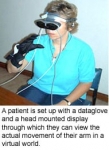 The four who received the Innovations in Stroke Care award are: Jacqueline Crosbie, Professor Suzanne McDonough and Dr Sheila Lennon from the Health and Rehabilitation Sciences Research Institute at Jordanstown along with Dr Michael McNeill from the School of Computing and Information Engineering, at Coleraine.
The four who received the Innovations in Stroke Care award are: Jacqueline Crosbie, Professor Suzanne McDonough and Dr Sheila Lennon from the Health and Rehabilitation Sciences Research Institute at Jordanstown along with Dr Michael McNeill from the School of Computing and Information Engineering, at Coleraine.
Congratulations from Positive Technology!
![]() Tags: virtual reality
Tags: virtual reality
More to explore
23:38 Posted in Positive Technology events | Permalink | Comments (0) | Tags: Positive Technology
Sep 30, 2005
Immersion and Virtual Reality @ Interfaces Montréal
TUESDAY, 4th October 2005 Interface [s] Montréal 5:30pm
From aerospace to surgery, and in all things game related, the simulators and immersion environments developed to serve humankind are indispensable tools that significantly improve human knowledge and enhance our reality experience.

Speakers: Yves Gonthier - Canadian Space Agency; Jean-Claude Artonne - Immervision; Jocelyn Faubert - Université de Montréal, École d'optométrie; Carl-Éric Aubin - École Polytechnique de Montréal, Dép. génie mécanique & CHU Sainte-Justine; Luc Courchesne - Université de Montréal et Ideaction.
[Yves Gonthier]: A Real-Time Simulator for 3D Mental Image Reconstruction On-Board the International Space Station
[Jean-Claude Artonne] Immervision: Panoramic technologies in everyday applications[Jocelyn Faubert] : Understanding human behavior with immersive virtual environments
[Carl-Éric Aubin] Surgical Simulator for the Virtual Prototyping of the Surgical Instrumentation of the Scoliotic Spine
[Luc Courchesne] Panoscope 360°
![]() Tags: virtual reality
Tags: virtual reality
11:50 Posted in Positive Technology events | Permalink | Comments (0) | Tags: Positive Technology
Sep 29, 2005
Virtual reality helps stroke patients learn to drive again
Sept. 27 issue of Neurology reports results of a study, which has investigated the effect of simulator-based training on driving after stroke. The research has involved 83 subacute stroke patients randomly assigned to either simulator-based training or control group. Then, all patients were evaluated in off-road and on-road performance tests to assess their driving ability after training.  Results showed that virtual reality training improved driving ability, especially for well educated and less disabled stroke patients. However, authors warn that findings of the study may have been modified as a result of the large number of dropouts and the possibility of some neurologic recovery unrelated to training.
Results showed that virtual reality training improved driving ability, especially for well educated and less disabled stroke patients. However, authors warn that findings of the study may have been modified as a result of the large number of dropouts and the possibility of some neurologic recovery unrelated to training.
More to explore
A. E. Akinwuntan, W. De Weerdt, H. Feys, J. Pauwels, G. Baten, P. Arno, and C. Kiekens Effect of simulator training on driving after stroke: A randomized controlled trial, Neurology 2005 65: 843-850
Sung H. You, et al., Virtual Reality–Induced Cortical Reorganization and Associated Locomotor Recovery in Chronic Stroke: An Experimenter-Blind Randomized Study, Stroke, Jun 2005; 36: 1166 - 1171.Sveistrup, H. Motor rehabilitation using virtual reality, Journal of NeuroEngineering and Rehabilitation 2004, 1:10 (download full text)
16:25 Posted in Cybertherapy | Permalink | Comments (0) | Tags: Positive Technology, virtual reality
Sep 28, 2005
The singularity is near
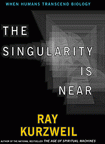 Here is a quote from a New Scientist article that sums up Kurzweil's projections:
Here is a quote from a New Scientist article that sums up Kurzweil's projections:
"Ultimately, we will merge with our technology. This will begin with nanobots in our bodies and brains. The nanobots will keep us healthy, provide full-immersion virtual reality from within the nervous system, provide direct brain-to-brain communication over the internet and greatly expand human intelligence. But keep in mind that non-biological intelligence is doubling in capability each year, whereas our biological intelligence is essentially fixed. As we get to the 2030s, the non-biological portion of our intelligence will predominate. By the mid 2040s, the non-biological portion of our intelligence will be billions of times more capable than the biological portion. Non-biological intelligence will have access to its own design and will be able to improve itself in an increasingly rapid redesign cycle."
Via smart mobs10:50 Posted in Brain training & cognitive enhancement | Permalink | Comments (0) | Tags: Positive Technology, Cognitive prosthetics
Sep 24, 2005
Open-Source Context-Aware Experience Sampling Tool
Ambient Intelligence (AmI) systems can be viewed as environments in which people will increasingly live their lives. Ubiquitous AmI technologies and systems like personal digital assistants, wearable sensors, mobile phones challenge traditional usability evaluation methods, because use context can be difficult to recreate in a laboratory setting. This view suggests that the evaluation of user’s experience with AmI systems should take place in realistic contexts, such the workplace, the home, etc. Another issue has to do with the content of the evaluation. Performance-based approaches are not suitable for AmI systems, because it is difficult to specify tasks that capture the complexity of real world activities. Moreover, experience is idiosyncratic, in that it is related to the specific bio-cultural configuration of each individual, and it can undergo changes throughout individual life and daily situations.
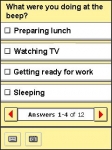 The Experience Sampling Method (ESM) offers a new perspective in the analysis of these issues. ESM is based on the online repeated assessment of individual behavior and experience in the daily context. Participants describe themselves and their environment while interacting with it. They carry with them for one week an electronic beeper and a booklet of self-report forms. Whenever they receive an acoustic signal, they are expected to fill out a form. The form contains open-ended questions about situational variables such as place, activities carried out, social context, and subjective variables such as the content of thought, perceived goals, and physical conditions. The form also contains 0-12 Likert-type scales investigating the quality of experience in its various components: affect, motivation, activation, and cognitive efficiency.
The Experience Sampling Method (ESM) offers a new perspective in the analysis of these issues. ESM is based on the online repeated assessment of individual behavior and experience in the daily context. Participants describe themselves and their environment while interacting with it. They carry with them for one week an electronic beeper and a booklet of self-report forms. Whenever they receive an acoustic signal, they are expected to fill out a form. The form contains open-ended questions about situational variables such as place, activities carried out, social context, and subjective variables such as the content of thought, perceived goals, and physical conditions. The form also contains 0-12 Likert-type scales investigating the quality of experience in its various components: affect, motivation, activation, and cognitive efficiency.
Intille and colleagues at MIT have recently developed a Personal Digital Assistant-based version of the ESM which can be used for user-interface development and assessment of ubiquitous computing applications. This approach, called Context-Aware Experience Sampling, includes the possibility to assess user’s experience not only through the standard time-based protocol, but also according to the participant’s location, by means of information provided by a GPS plug-in. Thus, researchers can design experiments collecting self-reports only when the participant is near a location of interest. Moreover, users can answers via audio recording or by taking a picture with a camera.
More to explore
S. S. Intille, J. Rondoni, C. Kukla, I. Ancona, L. Bao, A context-aware experience sampling tool, CHI Extended Abstracts 2003, 972-973.
Gaggioli, A., Optimal Experience in Ambient Intelligence (2005), in Ambient Intelligence, Riva, G., Vatalaro, F., Davide, F., Alcañiz, M. (Eds.), Amsterdam: IOS Press. PDF
10:00 Posted in Research tools | Permalink | Comments (0) | Tags: Positive Technology, research tools
Sep 23, 2005
Scientific American Mind
The new edition of Scientific American Mind
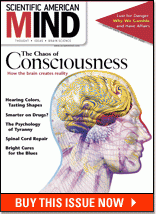
Smarter on Drugs
By Michael S. Gazzaniga
We recoil at the idea of people taking drugs to enhance their intelligence. But why?
The Movie in Your Head
By Christof Koch
Is consciousness a seamless experience or a string of fleeting images, like frames of a movie? The emerging answer will determine whether the "real world" is merely an illusion
Big Answers from Little People
By David Dobbs
In infants, Elizabeth Spelke finds fundamental insights into how men and women think
Custody Disputed
By Robert E. Emery, Randy K. Otto and William O'Donohue
The guidelines judges and psychologists use to decide child custody cases have little basis in science. The system must be rebuilt on better data
Judging Amy and Andy
By Katja Gaschler
Contrary to warnings, we can size up people pretty well based on first impressions
Hearing Colors, Tasting Shapes
By Vilayanur S. Ramachandran and Edward M. Hubbard
People with synesthesia--whose senses blend together--are providing valuable clues to understanding the organization and functions of the human brain
The Psychology of Tyranny
By S. Alexander Haslam and Stephen D. Reicher
Power corrupts, and absolute power corrupts absolutely--or does it?
Mending the Spinal Cord
By Ulrich Kraft
Researchers are finding ways to help nerves regenerate, and hope for therapies is growin
Just a Bit Different
By Ingelore Moeller
With special training early in life, children born with Down syndrome have a higher chance of becoming independent
22:39 Posted in Positive Technology events | Permalink | Comments (0) | Tags: Positive Technology
Media Fabrics
Interactive Cinema - Media Fabrics is a research initiative at MIT that focuses on a new paradigm: the "media fabric" - a semi-intelligent organism where lines of communication,  threads of meaning, chains of causality, and streams of consciousness converge and intertwine to form a rich tapestry of creative story potentials, meaningful real-time dialogues, social interactions, and personal or communal art- and story-making.
threads of meaning, chains of causality, and streams of consciousness converge and intertwine to form a rich tapestry of creative story potentials, meaningful real-time dialogues, social interactions, and personal or communal art- and story-making.
More to explore
The Media Fabrics website
13:35 Posted in Cyberart | Permalink | Comments (0) | Tags: Positive Technology, cyberart
The Virtusphere
Via Engadget
VirtuSphere is a 360-degree VR environment that allows for moving in any direction. The device consists of a large hollow sphere, placed on a special platform that allows the sphere to rotate in any direction as the user moves within it. Sensors under the sphere provide subject speed and direction to the computer running the simulation and users can interact with virtual objects using a special manipulator.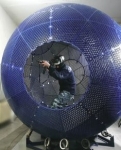
According to Virtusphere staff, the device has several potential applications in the field of training/simulations, health/rehabilitation, gaming and more. The device cost should range between $50K and $100K.
More to explore
13:30 Posted in Cybertherapy | Permalink | Comments (0) | Tags: Positive Technology, virtual reality
Sep 22, 2005
Neuroprotection in Neurological Diseases Conference
Neuroprotection in Neurological Diseases - A Promising Therapeutic Strategy or Chimera?
24-26 November 2005
Giardini Naxos (Taormina), Sicily
 Achieving proven Neuroprotection remains an unattained goal; however strategies exist which may delay disease progression in chronic conditions and which show promise of damage limitation in the acute setting. The conference will discuss best treatment practice, present new research and debate issues surrounding Neuronal Plasticity and Neuroprotection.
Achieving proven Neuroprotection remains an unattained goal; however strategies exist which may delay disease progression in chronic conditions and which show promise of damage limitation in the acute setting. The conference will discuss best treatment practice, present new research and debate issues surrounding Neuronal Plasticity and Neuroprotection.
The draft programme is available at www.sinspn.org
13:15 Posted in Positive Technology events | Permalink | Comments (0) | Tags: Positive Technology







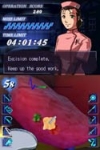 Trauma Center: Under the Knife puts the gamer in the role of a surgeon fighting a deadly epidemic. Funny, but as noted by Wired's reporter Chris Kohler, the
Trauma Center: Under the Knife puts the gamer in the role of a surgeon fighting a deadly epidemic. Funny, but as noted by Wired's reporter Chris Kohler, the